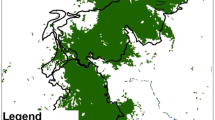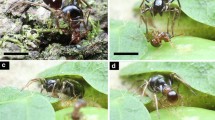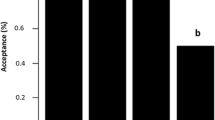Abstract
Crematogaster sp. is a dominant arboreal ant species that captures and retrieves very large prey. Hunting workers forage collectively thanks to short-range recruitment. They detect prey by contact, then rapidly attack, seizing small prey by the body and large prey by a leg. In this study, almost all the active prey were spread-eagled by several workers, even when small enough to permit a single worker to easily master them. While certain workers spread-eagled the prey, others deposited venom on the prey body using their spatulated sting (topical action of the venom). The well-developed arolia on the pretarsus of workers' legs have crucial importance for the success of prey capture (spread-eagling) and transport in an arboreal habitat. These results are compared with those known for other arboreal-dwelling generalist predator ant species.
Similar content being viewed by others
REFERENCES
Adams, E. S. (1994). Territory defense by the ant Azteca trigona: Maintenance of an arboreal ant mosaic. Oecologia 97: 202-208.
Dejean, A. (1987). Effect of prey size on predatory behavior of Serrastruma serrula (Hymenoptera: Formicidae, Myrmicinae). Sociobiology 13: 295-306.
Dejean, A. (1990). Prey capture strategy of the african weaver ant. In Vander Meer, R. K., Jaffe, K., and Cedeno, A. (eds.), Applied Myrmecology, a World Pespective, Vol. 43, Westview Press, Boulder, pp. 472-481.
Dejean, A., and Corbara, B. (1998). Study of different foraging paths of the predatory Neotropical ponerine ant Pachycondyla (DNeoponera) villosa (Hymenoptera, Formicidae). Sociobiology 32: 409-426.
Dejean, A., Lenoir, A., and Godzinska, E. J. (1994). The hunting behavior of Polyrhachis laboriosa, a non-dominant arboreal ant of the African equatorial forest (Hymenoptera: Formicidae, Formicinae). Sociobiology 23: 293-313.
Dejean, A., McKey, D., Gibernau, M., and Belin-Depoux, M. (2000). The arboreal ant mosaic in a Cameronian rainforest. Sociobiology 35: 403-423.
Federle,W., Rohrseitz, K., and Hölldobler, B. (2000). Attachment forces of ants measured with a centrifuge: Better “wax-runners” have a poorer attachment to a smooth surface.J. Exp. Biol. 203: 505-512.
Freeland, J., Crozier, R. H., and Marc, J. (1982). On the occurrence of arolia in ant feet. J. Aust. Entomol. Soc. 21: 257-262.
Hölldobler, B., and Lumdsen, C. J. (1980). Territorial strategies in ants. Science 210: 732-739.
Hölldobler, B., and Wilson, E. O. (1978). The multiple recruitment systems of the African weaver ant Oecophylla longinoda (Latreille) (Hymenoptera: Formicidae). Behav. Ecol. Sociobiol. 3: 19-60.
Hölldobler, B., and Wilson, E. O. (1990). The Ants, Harvard University Press, Cambridge, MA.
Kenne, M., Schatz, B., Durand, J.-L., and Dejean, A. (2000). Hunting strategy of a generalist ant species proposed as a biological agent against termites. Entomol. Exp. Appl. 94: 31-40.
Majer, J.D. (1993). Comparison of the arboreal ant mosaic in Ghana, Brasil, Papua New Guinea and Australia: Its structure and influence of ant diversity. In LaSalle, J., and Gauld, I. D. (eds.), Hymenoptera and Biodiversity, CAB International, Wallingford, pp. 115-141.
Orivel, J., and Dejean, A. (1999). L'adaptation `a la vie arboricole chez les fourmis. Ann. Biol. 38: 1-18.
Orivel, J., Souchal, A., Cerdan, P., and Dejean, A. (2000). Prey capture behavior of the arboreal ponerine ant Pachycondyla goeldii (Hymenoptera: Formicidae). Sociobiology 35: 131-140.
Rice, W. R. (1989). Analyzing tables of statistical tests. Evolution 43: 223-225.
Schatz, B., Lachaud, J. P., and Beugnon, G. (1997). Graded recruitment and hunting strategies linked to prey weight and size in the ponerine ant Ectatomma ruidum. Behav. Ecol. Sociobiol. 40: 337-349.
Traniello, J. F. A. (1989). Foraging strategies of ants. Annu. Rev. Entomol. 34: 191-210.
Wojtusiak, J., Godzinska, E. J., and Dejean, A. (1995). Capture and retrieval of very large prey by workers of the African weaver ant, Oecophylla longinoda (Latreille 1802). Trop. Zool. 8: 309-318.
Author information
Authors and Affiliations
Corresponding author
Rights and permissions
About this article
Cite this article
Richard, FJ., Fabre, A. & Dejean, A. Predatory Behavior in Dominant Arboreal Ant Species: The Case of Crematogaster sp. (Hymenoptera: Formicidae). Journal of Insect Behavior 14, 271–282 (2001). https://doi.org/10.1023/A:1007845929801
Issue Date:
DOI: https://doi.org/10.1023/A:1007845929801




